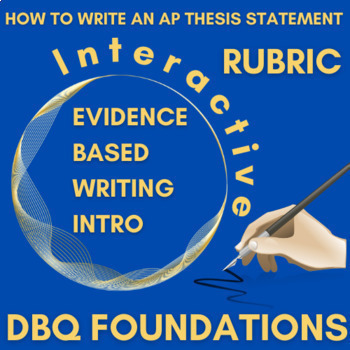What is an Argument? (Interactive Intro to Argumentation, AP or Back to School)
- Google Slides™

Description
This is the perfect first day of school activity to get to know your kids while also teaching basic foundations for argumentation and thesis statements. I saw IMMEDIATE results in my students writing and reasoning due to this lesson. I have personally used it for middle school level classes up to AP History classes.
This is a one day lesson set out in a Google Slide Presentation. Each slide has directions for the class in the presenter comments, and one slide is an introduction slide for the individual teacher if doing on the first day of school (so be sure to fill that out for yourself!). I have provided 4 different rubrics (2 basic out of 6 and 10 points and 2 advanced out of 9 and 15 points) at the end of the Slideshow.
The only lesson prep required is to fill in your own introduction page and decide which rubric you will use. The only thing students need is a pencil and paper.
General Advice:
This lesson is great to use for all 6-12 grade as an introduction for argumentation and thesis statement writing. There are some specific things I outline that you can use to modify for your individual classroom. It is interactive in that you can make this a partner or group activity, a mixer, or even a whole classroom demonstration, depending on your classroom dynamic. There is even an extension activity that explains how it can be modified to make it even more collaborative or how to mix in some good old fashioned competition.
First Day of School Advice:
If you use this for the first day of school, one slide is for you to fill in as a 'teacher introduction'. It is fun because it works with the lesson as one of your first examples with the kids. It also allows the students to introduce themselves to you and the rest of their class.
Middle School Advice:
This is a fun way to introduce kids to historical argumentation--the idea of how to not make an "I believe" statement, but rather to try to CONVINCE the audience that they are actually correct. It's also just a good way to get to know the kids, even if you've already taught them for a while. I would suggest skipping the slide about counterarguments for middle school and focus on just creating debatable claims instead, for this one-day lesson.
AP Advice:
This is essentially the first step toward writing a DBQ. I use this lesson to set the foundation for the entire year of historical writing in my classroom. I teach the students not only how to make a good argument, but also an 'AP' style thesis statement. It is fun for the kids because it is a low pressure way to learn this concept, but it is also FOUNDATIONAL for teaching them how to write complexly (even with counter-arguments) for the rest of the year. I find myself referencing back to this activity to help to hone their writing skills later on. (See AP Standards linked below if you'd like to know how this lesson works) Be sure to use the 15 point ADVANCED rubric for your students here. This could also work as a sort of Pre-Test for you to get an idea of who can clearly write and argue already without much guidance.
AP Standards addressed: AP World History: Modern, AP US History, AP European History
6.A Make a historically defensible claim.
6.B Support an argument using specific and relevant evidence.
- Describe specific examples of historically relevant evidence.
- Explain how specific examples of historically relevant evidence support an argument.



